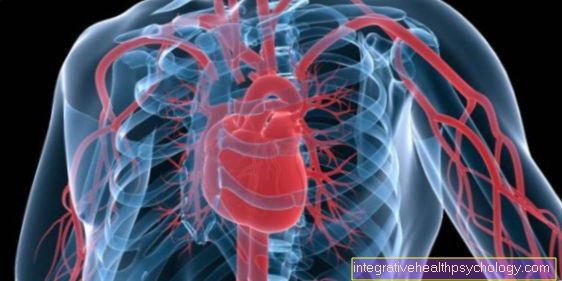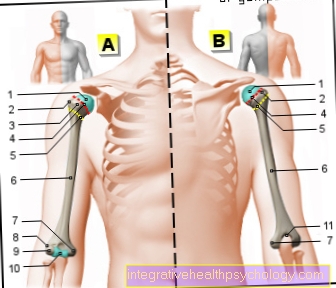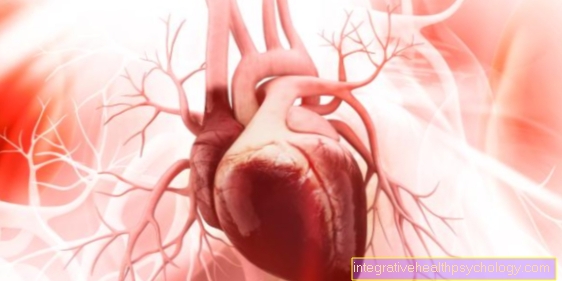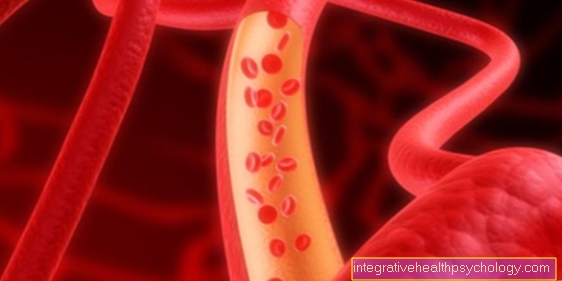What is typhoid?
Typhoid is an infectious disease that is transmitted by a specific type of salmonella. It occurs primarily in Africa, South America, and Southeast Asia and can only cause symptoms months after it is transmitted.
Typhoid initially leads to persistent constipation and fever. Later, there is often typical reddening of the abdominal skin, thinning of the stool and a slowdown in the heart rate (also called bradycardia).
There are also changes in the blood and people are often drowsy. Typhoid is treated with antibiotics. In risk areas you can also vaccinate against typhoid.
Read more at: Salmonella and Bradycardia

Causes of Typhoid
Since typhoid is an infectious disease, the cause lies in the transmission of the disease by a pathogen. In typhoid fever, this is a specific type of salmonella, bacteria that are mainly found in humans. The pathogens are transmitted either directly from person to person or indirectly through contaminated drinking water. In direct infection, the pathogens are transmitted through contact between one person and the infected stool of another person.
This can happen if a person, after suffering from typhoid fever, becomes the so-called permanent excretor of salmonella and these are now found in the stool of the person concerned.
If salmonella gets into a person's body, it can attack certain structures of the immune system in the small intestine. They infect so-called macrophages, which serve as cells for the immune system, and thereby reach the bone marrow, liver, spleen and lymph nodes.
In the later course of the disease, all organs are infected by the multiplication of Salmonella and the spread via the blood.
You can find a detailed overview of all tropical diseases under the article: Overview page on tropical diseases
How is typhoid transmitted?
Typhoid can be transmitted either directly or indirectly. In the direct route, the pathogen is transmitted through contact between one person and the infected stool of another person. The bowel movement can be infected by a typhoid fever that you had previously suffered.
With the indirect route, the pathogens are transmitted through contaminated food. Contaminated water, for example due to a lack of separation of drinking water and wastewater, can also lead to indirect transmission of salmonella
How contagious is typhoid?
Typhus is an infectious disease that leads to typical symptoms when infected. Infection occurs either directly from person to person or indirectly, for example through contaminated drinking water.
In the case of a direct route, the infection occurs through the excretion of salmonella in the stool. This begins about a week after the onset of the disease. However, the elimination of the pathogen is often not accompanied by a decrease in symptoms. It can be present weeks later and in about 5% of all cases even persists for life without any further symptoms.
These so-called salmonella permanent eliminators are therefore not allowed to work with food, for example, as the risk of infection is too high.
After infection with the typhoid-causing salmonella, it often takes one to two weeks for symptoms to break out. However, it can take up to 2 months for symptoms to become apparent. This very long period is very treacherous and increases the risk of unwitting further infection.
Since typhoid can spread very quickly, there is an obligation to report by name in Germany even if the disease is suspected. This also applies to the actual presence of the disease, a positive laboratory result or the death of a person from typhoid.
diagnosis
Typhoid can be diagnosed differently depending on the time of the illness. At the beginning of the symptoms, the pathogens can be detected in the blood with the help of a so-called blood culture.
Approx. 2-3 weeks later, the salmonella can also be found in the stool. This is done with a so-called stool culture. From the 3rd week of the disease, antibodies that are formed by the immune system for defense can also be detected.
In addition, there is the typical blood count of typhoid fever with a deficiency of white and red blood cells (leukocytopenia and eosinopenia) and an increase in immune cells (lymphocytosis).
I recognize typhoid by these symptoms
Typhoid fever is characterized by the fact that the symptoms appear in different stages and change depending on the stage. They usually appear after 1-3 weeks.
- In the first stage there is constipation and a slow development of fever. Abdominal pain and headache as well as impaired consciousness also occur frequently. The first stage lasts about a week and is not always recognized quickly due to the sometimes unspecific symptoms.
- The 2nd and 3rd weeks of the disease form the second stage. This leads to the so-called continuous fever, in which the body temperature is constantly above 38 ° C, but fluctuates a little every day. There is a drop in heart rate and abdominal pain. In about 30% of all those affected, small red spots appear on the skin of the abdomen, which are also known as roseoles. Pea-like stools and clouding of consciousness often occur. The typhoid tongue can also be observed at this stage from time to time.
- In the last stage, 3 weeks after the onset of the disease, the symptoms slowly subside.
Typhoid tongue
In the second and third weeks of typhoid fever, the so-called typhoid tongue can occur in rare cases. A grayish-white coating forms in the middle of the tongue. This is surrounded on the edge and the tip of the tongue by free, strongly reddened edges.
Rash
About 30% of all people who contract typhus develop a rash during the 2nd stage, i.e. the 2nd and 3rd week of the disease.
This is located on the skin of the chest and abdomen and is usually located around the navel. This creates the image of small reddish spots.
They are often only visible for a short period of time, but they are very characteristic of the disease. In the medical field, they are also known as roseoles.
fever
Different types of fever develop in the course of typhoid fever. Initially, in the first week there is a slow rise in body temperature, which occurs in stages. In the 2nd and 3rd week of the infectious disease, the so-called continuous fever occurs.
The body temperature is constantly above 38 ° C. However, it fluctuates slightly over the course of a day. This fever is very characteristic, as it does not lead to chills - as is typical with fever - and it also only responds very poorly to antipyretic medication.
Read more on the subject under: Skin rash after fever
Treatment and therapy
The bacterial infectious disease typhoid is treated with the help of antibiotics. Nowadays, the antibiotic ciprofloxacin is the most commonly given drug to treat typhoid fever.
Alternatively, ofloxacin can also be given as it is a similar drug. The antibiotic is taken for 7-10 days.
Before starting therapy, any resistance of Salmonella to antibiotics should be determined. If there is such a resistance, the given drug may not be able to work, which delays the healing of the disease. In this case, other antibiotics, such as ceftriaxone, are available.
Since salmonella is bacteria that live inside the body's cells, it usually takes a few days for the fever to subside with therapy.
In about 5% of all people suffering from typhoid, after the symptoms have healed, the pathogens are permanently excreted in the stool. This is very dangerous as it can infect other people in the vicinity. With such so-called salmonella permanent excretors, antibiotics are prescribed for a longer period of time. This tries to remove the more stubborn pathogens that are still present from the body.
Usually, in such cases, ciprofloxacin for 4 weeks or ceftriaxone for 2 weeks is recommended.
Read more on the subject under: Antibiotics
vaccination
There is a vaccination against typhoid fever. This is not generally recommended in Germany, but recommended when traveling to risk areas. These include Southeast Asia, Central Africa, West Africa and South America. It is recommended to have a vaccination before traveling to these areas for a long time.
There are two types of typhoid vaccines:
- The inactivated vaccine, which contains dead pathogen particles, can be injected intramuscularly, i.e. into the muscle. This vaccination can be given from the age of 2 and a single dose offers vaccination protection for up to 3 years. The vaccine has the trade name Typhim Vi® and is generally well tolerated. However, studies show that the dead vaccine only works in about 60% of all cases.
- The live vaccine bears the trade name Typhoral-L® It consists of a mixture of harmless living and inactivated Salmonella. Here it is taken as a tablet, i.e. orally.
- There is also a vaccination schedule, which means in this case that a total of 3 tablets are taken every 2 days. This vaccine can also be given from the age of 2, but has a similar potency as the dead vaccine.
Read more on the subject at:
- Typhoid vaccination
- Vaccinations in the baby
- Vaccinate
Duration and forecast
Typhoid fever usually lasts about 3 weeks, which means that the symptoms subside 3 weeks after the first symptoms begin.
The incubation period, i.e. the time between infection and the appearance of the symptoms, usually lasts about 2 weeks, but in some cases it can last up to 2 months.
After the symptoms have subsided, the prognosis for typhoid fever is usually good. Occasionally, complications such as bleeding in the bowel or inflammation of the meninges, also known as meningitis, can occur.
A completed infection with the typhoid pathogen does not offer lifelong immunity against the disease.
Read more on the topic under: Meningitis
Course of disease
The course of typhoid fever can be divided into three stages, in which different symptoms appear.
- The first week of illness with a slight fever and constipation is also known as the stage incrementi.
- In the second so-called stage fastigii, the peak of the disease, the symptoms are maximal.
- After this stage, which lasts about 2 weeks, the symptoms subside. This is also known as the stage decrementi, i.e. the decrease.
What can be the long-term effects of typhus?
In about 5% of all those suffering from typhus, the pathogen is then permanently excreted, which represents a high risk for people in the vicinity. This needs to be treated with antibiotics. Typhoid fever can occasionally lead to further complications, which theoretically can affect any organ.
The intestine is more frequently affected and bleeding or perforation can occur, which creates holes in the intestinal wall. Other complications include inflammation of the meninges, also called meningitis, or kidney failure.
Paratyphoid is also an infectious disease that is similar to typhoid. However, it is transmitted by a different type of salmonella that can affect animals as well as humans.
Paratyphoid diseases are common in India, the Balkans and Pakistan. In contrast to typhus, paratyphoid fever is more likely to have diarrhea. Otherwise the symptoms, diagnosis and therapy of typhoid diseases are similar.














.jpg)














